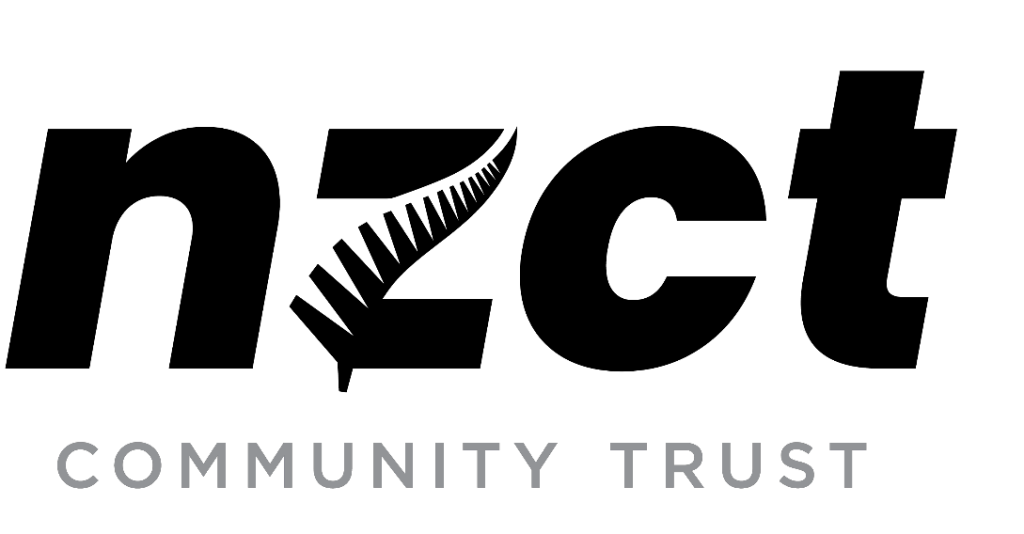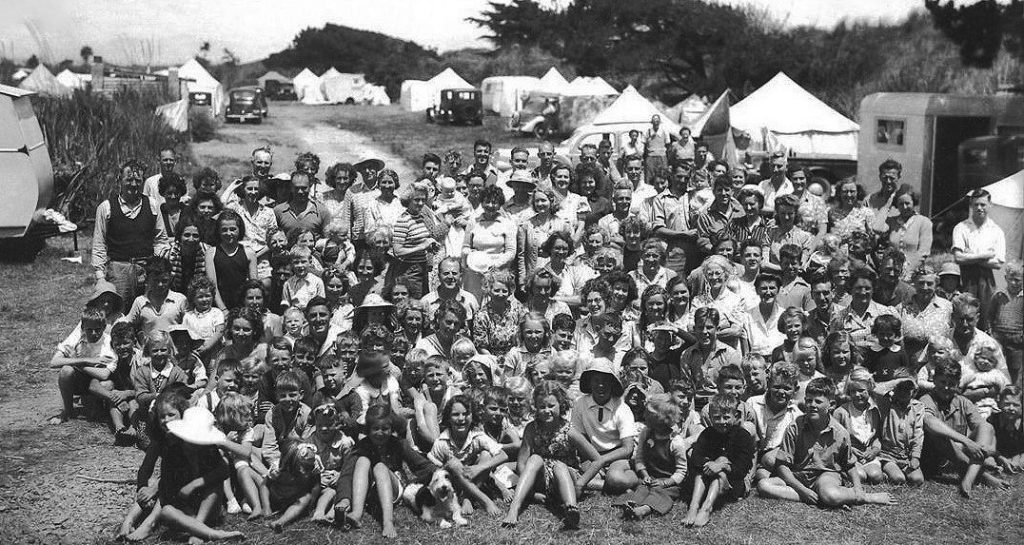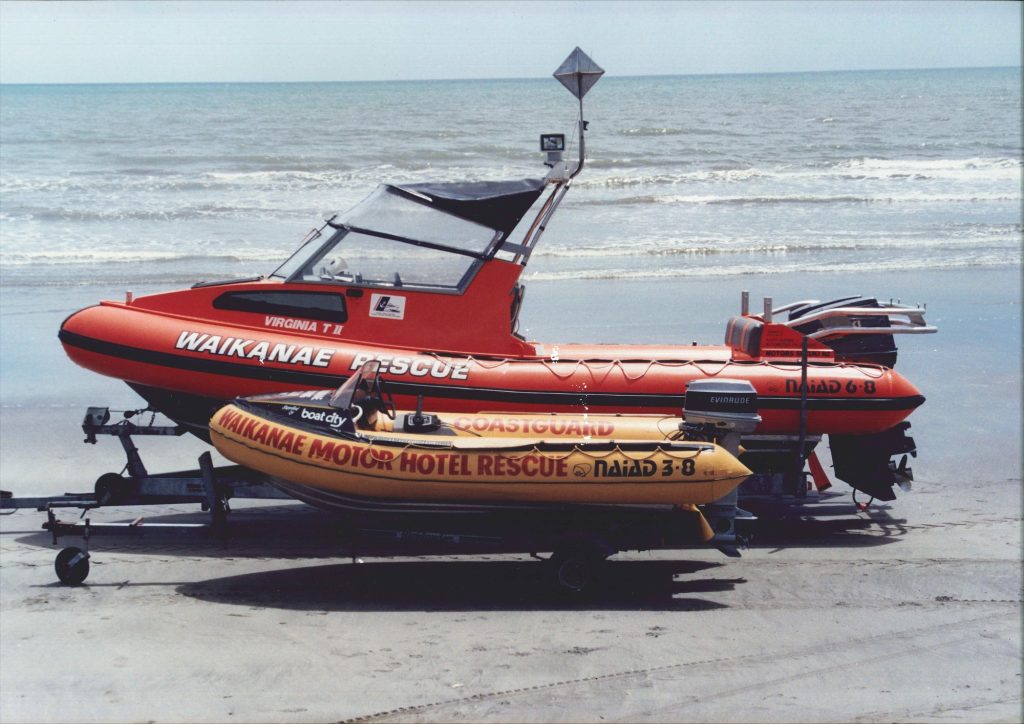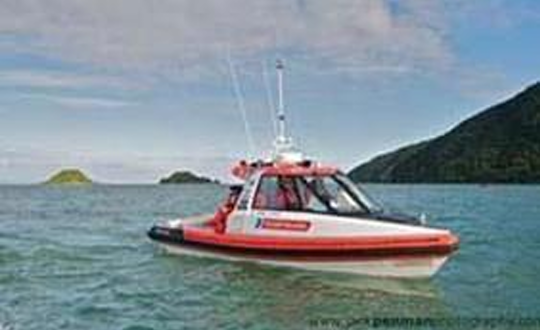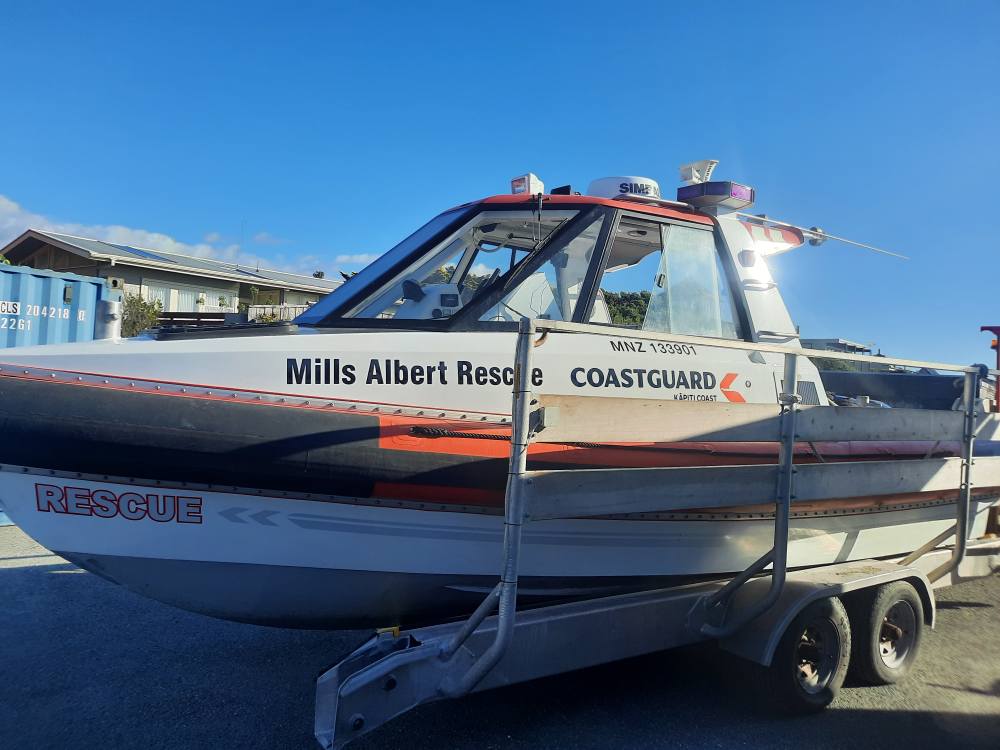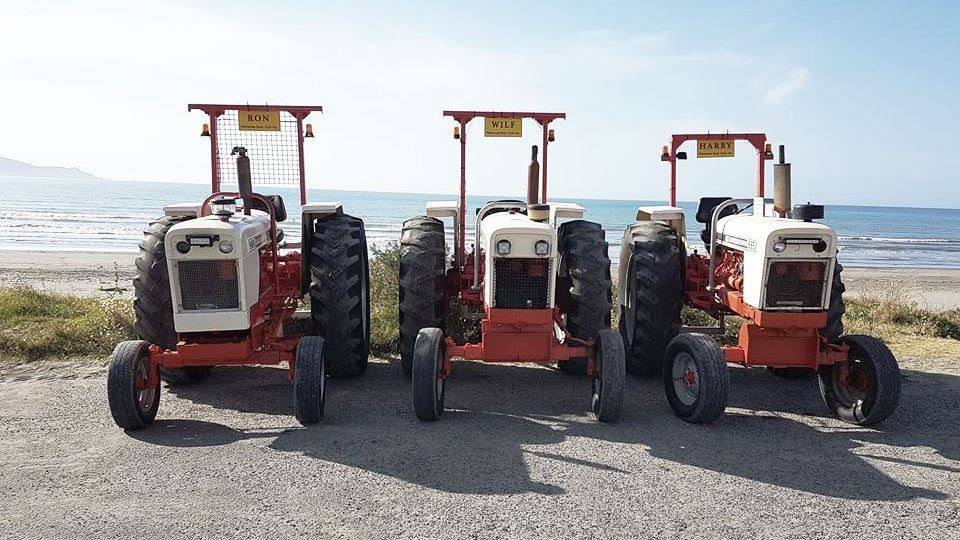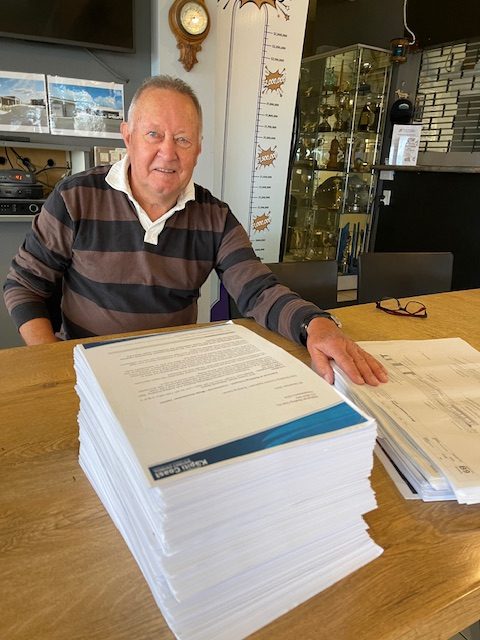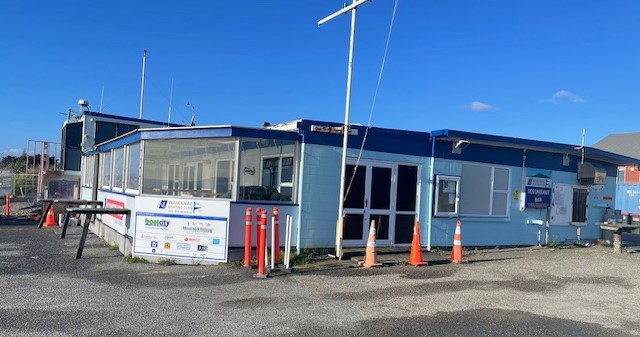WAIKANAE BOATING CLUB HISTORY
Compiled by Life Member and former Commodore Chris Turver, a member since 1988 as his gift to recognise the rebuild effort – May 2025
FROM WINDSWEPT SAND TO POPULAR BOATING CLUB
Recreational boating and fishing at Waikanae Beach started to become a way of life from the 1940s and today we provide the only safe recreational boat launching point between Waikanae river and Otaki.
There was beachfront, but no club house, and locals and holidaymakers used available farm tractors or trucks to launch boats down a sandy beach cutting at the seaward end of Waimea Road.
In 1943 one of Waikanae’s first real estate agents Wilf Harry became the second owner of an emerging motor camp on 32 acres of beach front stretching from what is now the Boating Club to Eruini Street and along both sides of Tutere Street.
It was part of the Ngarara West Block and he took ownership of Lot 62 on DP7203.
Wilf’s daughter Jenny Algar, who lived close by, recounts how quiet and peaceful life was outside the holiday season and her enjoyment of horse riding over miles of undeveloped beachfront and selling camper essentials from the local campers shop.
Gradually the Waikanae Beach Motor Camp grew with tents and caravans, some owned by surfcasters and boat owners, and relying on long drops and collected rainwater to get through hot summers.
An early gift to the fishing community was a small block of land at the north end of the motor camp which was part of a designated recreational reserve under Horowhenua County Council, complete with public toilet facilities.
Wilf grew the camp until selling it in 1975, opening the way for serious residential sub-divisions and a rapidly increasing population
HOW WE STARTED
It was the early boat owners who informally formed Waikanae Boating Club in 1961 and formally constituted in 1966 with Waikanae resident Oswald (Ossie) Olliver as the first Commodore and 21 members.
At the 1966 AGM it was clear discussions had already started with the then Horowhenua County Council for the lease of ‘the Domain area for the erection of a ‘Pavilion’ (club house) for the new boating club.
The only building on the site at the time was the original HCC public toilet block, finally demolished in 2025 after approximately 60 years service.
In October 1966 the committee met to determine the site of a proposed building, peg the site, and a month later a draft lease was tabled.
At the same meeting the committee saw the start of what would become a forerunner for a Coastguard role as a report was received on discussions with the HCC Civil Defence Controller inviting the names and contact details of volunteer members who could be called out in a marine emergency.
In February 1967 a rough beach access launching track from the building site was reinforced by volunteers free of charge with loose fill and ‘general satisfaction was expressed’ by the committee’. It is still in use today.
In April 1967 it was back to square one with the club house when the HCC County Engineer calling a meeting to discuss resiting the planned building so it ‘was more in line with the HCC toilet block’ and providing a concrete floor for the new building.
At the AGM two months later the Commodore reported that building plans had been prepared and talks had been held with neighbours and the Waikanae County Town Committee (now Waikanae Community Board).
It was stressed that the club was now under ‘some obligation to proceed’ as a condition of the lease and by September 1967 one ‘tentative quote’ had been received that led to suggestions for seeking quotes from trade members.
By November 1967 the HCC had produced a draft lease but the committee wanted further answers. By June 1968 the AGM had approved the terms and was considering how to raise finance, with debentures discussed.
In July 1968 the Commodore expanded on the clubs emerging lifesaving role by proposing establishment an ’Aquatic section of Civil Defence’ which would allow the club to seek funds from Golden Kiwi and a letter was sent to the County Town Clerk suggesting that the club’s base radio be used for emergencies.
By September 1968 the HCC lease had been signed and Mr L Walton had been commissioned to draw up plans for the ‘Pavilion’ and provide a firm price for construction which were to be in the hands of the County Clerk by March 1969 with the goal of then re-advertising for tenders.
Some design changes were required by HCC, coupled with delays in getting neighbours approval.
Records are scanty between the eventual sign off of the plans and completion of the ‘Pavilion’ in 1970 but, anecdotally, the cost of the building (much of it with voluntary labour and donated materials) was minimal.
One of those donors was original member and future commodore George Hodson who had developed a commercial concrete block making plant which was used to make the building we have today.
The first AGM to be held in ‘the new clubrooms’ was on 13 June 1970 with 47 members under the chairmanship of Commodore Ossie Olliver.
To show how little has changed, agenda items discussed included increasing membership, the annual fishing competition and childrens day, a members trip around Kapiti Island, the registration of member boats, setting a $5 fee for use of an about-to-be acquired club tractor for members only, and the possibility of constructing a tractor shed.
By July 1971 when Ossie stepped down as Commodore, after 10 years in office, Club membership had reached almost 200 and the club badges and flag had been designed.
Subsequent Commodore’s who continued the development of the club were businessman George Hodgson (1970-72), N.V Beardsley (1972-73), T Guderson (1973-75), Ted King (1975-83) and then a return stint from Ossie Olliver in 1983.
(With thanks to Jenny Algar, daughter of Wilf Harry, for her knowledge of the early days and to the WBC’s early Minute Books)
COASTGUARD RESCUE VESSELS
Until the early 1980s, the Club had relied for mounting rescues on using its own members boats and a patchwork of local CB radio communications.
Waikanae Boating Club affiliated with the Royal New Zealand Coastguard Federation (RNZCF) in an effort to patch in to emerging national support services and established Waikanae Coastguard as part of its operations.
From the late1980s until the mid-1990s, Waikanae Coastguard relied on a 3.8 metre Naiad inshore rescue boat donated by the then Waikanae Motor Hotel, a 5 metre Plylite fibreglass half-cabin donated by local philanthropist Virginia Turner – and on members larger boats for offshore missions.
The then vice-commodore Chris Turver – soon to become the first CEO of the RNZCF – realised that the club could not go on expecting members to put their lives at risk with inadequate equipment and support and set about raising funds
Waikanae Coastguard’s first offshore rescue vessel ‘Waikanae Rescue’ was launched in 1996 with the purchase of a $35,000 6.8m Naiad rigid hulled inflatable powered by twin outboards.
This modern rescue vessel was one of the first to be commissioned as part of the RNZCF’s growing network of upgraded marine rescue units around the coast of New Zealand on the major lakes.
Funding was raised through Waikanae Community Board ($16,000), the Lottery Grants Board ($12,000), and local donors including members of WBC.
CB radios were progressively replaced with VHF radios and, through an agreement between the RNZCF and the Trade and Industry Department all Coastguard units were authorised to take over VHF training and charge for courses
From the late 1990s, training programmes were introduced for Coastguard crew members to reach standards set by the RNZCF, including Boatmaster and Day Skipper courses, and VHF radio training.
These courses spearheaded by our volunteers like Frank Tilly, Dick Milligan, Kevin Foothead, David Proctor, and Bruce Lawrie were offered to members of Waikanae Boating Club and became a popular way of improving boating capability and safety at sea.
A further step after buying ‘Waikanae Rescue’ was to fund-raise for electronic equipment including radar and electrical navigation equipment, particularly for use in night searches.
With growing demand for Coastguard services along the long stretch of dangerous coastline from Wellington to Foxton, it was clear greater co-ordination of lifesaving efforts was necessary.
In February 2006 Waikanae Coastguard amalgamated with the Paraparaumu-based Kapiti Coastguard to form Coastguard Kapiti Coast.
Since 2006 callouts have averaged more than 40 a year.
In 2009 the 13-year-old ‘Waikanae Rescue’ was replaced with ‘K2 Rescue’. a modern 7.3 metre diesel-engined jet boat costing $440,000, and in 2018 Kapiti Coastguard’s 27-year-old diesel jet boat ‘Pharazyn Rescue’ was replaced with a 9-metre diesel jet boat, “Freemasons Rescue” costing $400,000.
Both are long range vessels capable of dealing with bad conditions and Kapiti coast
is well covered for emergency searches.
K2
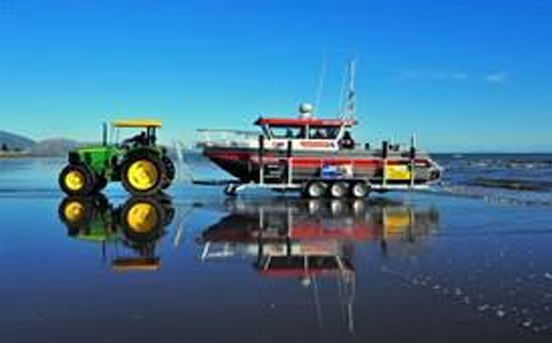
Freemasons Rescue
Mills Albert Rescue (MAR)
ROLE IN ESTABLISHING KAPITI MARINE RESERVE
A major battle was fought by Waikanae Boating Club between 1989-92 over plans by the Department of Conservation to block off almost half Kapiti Island from recreational fishing.
Background
In early 1989 the Department of Conservation prepared a discussion document on the “Protection of the Marine Environment around Kapiti Island”.
Its goal was to create the third marine reserve in New Zealand following the establishment of the Leigh reserve, north of Auckland, and Poor Knights Islands.
Had the original plan not been opposed by Waikanae Boating Club, with support from Kapiti Boating Club, Otaihanga Boating Club, Raumati Boating Club and Kapiti Underwater Club, the marine reserve would have been almost twice its size and seriously threatened boating safety.
WBC’S Commodore Mike Bramley and Vice Commodore Chris Turver led the opposition based on research which saw the Minister for Conservation reducing the planned scale in early 1992 to its present shape.
In the process, intensive lobbying with Kapiti Coast District Council and Wellington Regional Council persuaded them to withdraw their support for the original proposal and agree with the safer option.
The legacy is a marine reserve which gained general buy-in by recreational fishers because it preserved boating safety and led to regeneration of depleting resident fish stocks.
How it Started
DoC had a plan in 1988 which involved creating an on-shore Scientific Reserve covering the entire lower Waikanae river and estuary and linking that with a Marine Reserve around almost half Kapiti Island.
The goal was “to establish an environment of rich plant and animal communities” but while the value of the Marine Reserve has become internationally recognised, the Scientific Reserve established in 1992, failed through DoC neglect, extensive loss of marine habitat through urban development, sedimentation, and an unchecked shingle build up which is destroying many natural habitats.
Marine Reserve
When the plans were first mooted in 1989, there was widespread community support for the concept and a first discussion document was issued in 1990.
Boating club members became increasingly concerned with the realisation that the scale of the proposed reserve – particularly the exposed back of Kapiti Island – would create serious safety risks including:
– being caught in bad weather
– dangers from an original ban on anchoring in the reserve for safety
– breaking down
– facing a medical emergency
– few cellphones (in those days) and limited cellphone coverage
– losing VHF radio contact behind Kapiti Island
In the decade to 1990 eight people drowned in Kapiti waters from boating-related accidents and seven off Kapiti Island itself.
Discussions were held by WBC with Kapiti Boating Club, Kapiti Underwater Club, Otaihanga Boating Club, and Raumati Boating Club, leading to the formation of a consortium which twice negotiated with DoC senior staff for the final outcome of the modified plan which went out for final public consultation.
Conservation Minister Denis Marshall reported in late 1991 that from the 2,500 submissions there was 75 percent approval for the original plan, 17 percent support for the modified plan, and eight percent opposed to any reserve.
He accepted a modified marine reserve which was officially opened in May 1992.
Kapiti Marine Reserve Committee
WBC was invited with KBC to each nominate a recreational fishing representative on this Ministerially-appointed committee which had the job of setting policies and objectives aimed at improving the marine environment and building fish stocks.
Chris Turver was appointed by WBC and served for 15 years before the Marine Reserve Committee was disbanded in 2008 after doing its job in:
– developing public and recreational fisher acceptance for the value of a reserve and compliance with the rules
– building resident fish stocks
– promoting the value of the reserve nationally and to the local community
CONTROL OF INSHORE TRAWLING
In the late 1980s and early 1990s there was growing concern by recreational boaties and the public about the effects of inshore trawling on fish stocks – including through the inshore channel to Kapiti Island.
Trawlers and long liners were fishing close in shore, often lit up at night and snapper were the primary target, leading to marked reductions locally and nationally in stock numbers.
Waikanae Boating Club played a leading role in trying to find a solution and meetings with Wellington region trawlermen were held at WBC and Kapiti Boating Club to try to reach a voluntary agreement.
One consequence of the over-fishing was a big increase in inshore paddle crabs, the natural prey of snapper, and the emergence of a small Kapiti crab company, using boats and strings of set pots along the Kapiti coast.
The national fish-take quota system introduced in 1986 started to make a difference in limiting commercial snapper catches but it would take some years before numbers improved with a reverse consequential reduction in paddle crab numbers.
Following the establishment of Kapiti Marine Reserve in 1993, the Ministry of Fisheries (later Primary Industries) weighed in and the result was agreement to a no-trawling zone out to the 20-metre contour depth along the entire Kapiti Horowhenua shoreline.
It specifically includes a buffer zone around Kapiti Marine Reserve.
Breaches should still be reported to Ministry for Primary Industries on 0800 476 664 or online at poacher@mpi.govt.nzand giving, where possible, the name and number of the vessel, its general description, and the time and date of the observation so that MPI can take an apparent breach up with the company concerned.
WAIKANAE BOATING CLUB TODAY
Growth in recreational boating has seen family membership burgeon from 47 when the club building opened in 1971 to 850 now and resources are stretched.
Those resources include:
– a volunteer ship-to-shore radio service so that boat owners can call for help or information
– club webcam for members to log in to view coastal conditions
– a powerful most-weather Coastguard rescue vessel, making an average 40 rescues a year, up to a dozen of which are classified as life-threatening.
– periodic boating safety courses
– collaboration with the NZ Police and Kapiti Coastguard on search-and-rescue operations
– a home for the Waikanae Surf Club’s training programme for youngsters
– a special beach buggy to help disabled into the sea
– fishing outings on club members boats for children in need or with disabilities (you should see the expressions on their faces!)
– a club house offering a social base for members from Waikanae and the wider region including meetings, training, and a licensed bar and restaurant for members and logged in guests
– a venue for local community and business meetings and functions
– Children’s Christmas parties
– three sturdy tractors for members use to launch and retrieve boats and the big Coastguard rescue boat
With growing membership there was no option by 2018 but to make more effective use of our waterfront site by commissioning an architect-designed larger clubhouse and re-arranging the ‘deck chairs’ to create more space.
There were long interruptions caused by the covid virus, design work, and seven years of delays in getting resource consents, a building consent, and environment impact reports, including a long delay while experts established that no blue penguins nested in the adjacent dunes.
WBC Building committee chair Brian Frampton best illustrated the sheer scale of the paperwork at the Special General Meeting which gave the green light for the project in 2024…..
…..AND NOW THE FUTURE
From here…..
…..to here

It’s a simple and uncomplicated design which significantly increases floor space and improves layouts for the control tower, social and entertaining spaces, provides a meeting room, improved restaurant, and provides for a separated entrance way.
We had by April 2025:
– demolished the old adjacent 1960s public toilet block, with volunteer members labour and machinery, to make it possible to extend our present building, and laid a concrete floor over the site
– begun construction of our building extension at the northern end of the site
– supported a move by the KCDC to install an adjacent five-bay electronic public toilet block
– built a separate $300,000 operations shed for our Coastguard rescue boat to free up space in the present building. Funded by Waikanae Boating Club and Coastguard New Zealand, with a most generous grant of $100,000 received from New Zealand Community Trust (NZCT).
Despite extensive delays during an era of rising costs, the construction price has been held to $2.1 million and $1.4 million had been raised by May 2025 with many irons in the fire to seek the remainder.
It’s still planned to open the new building in December 2025 and, until then, there may be some work-related interruptions to services.
That we have managed to get this far is a tribute to our members support, to the generosity of key funders, and the willingness of our construction and ‘tradie’ members to get jobs done at least cost and they deserve special credit.
